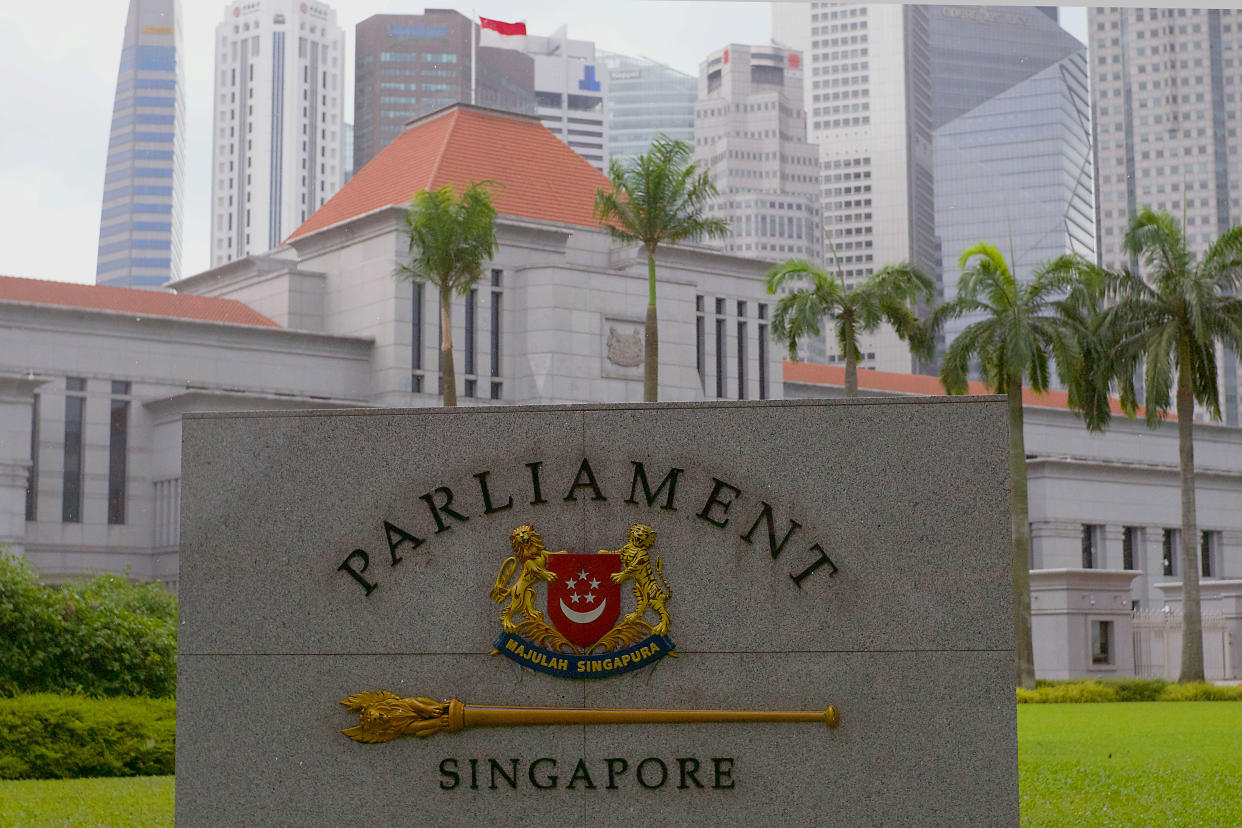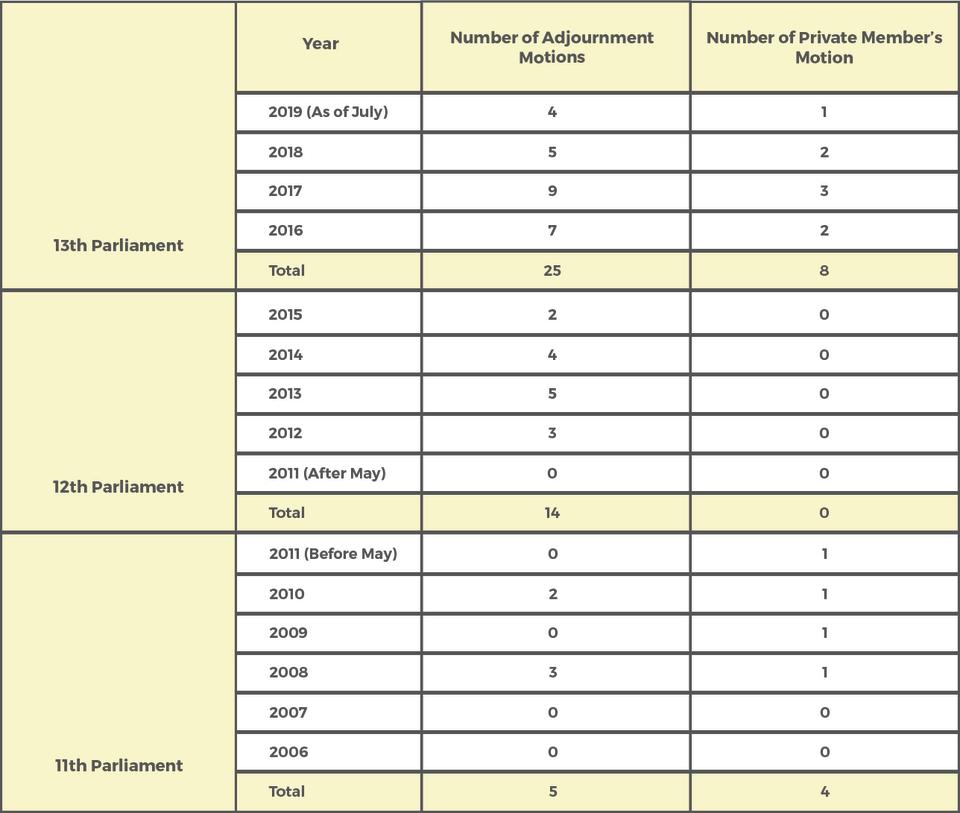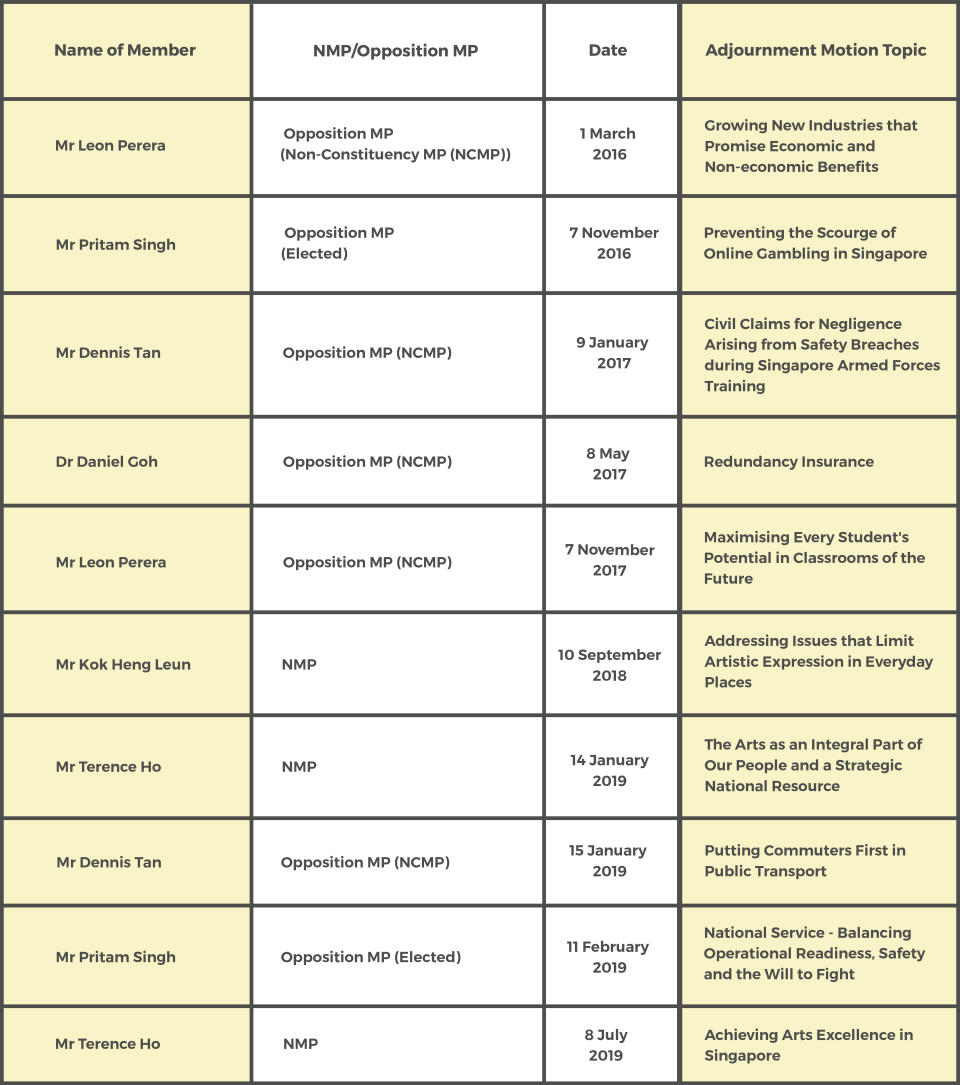Parliament: Record number of motions filed by MPs

By Bertha Henson and Sean Lim
SINGAPORE — A motion, in the parliamentary sense, has nothing to do with physics or bowel movements. Although, like bowel movements, it is getting to be a regular affair. More motions are being filed by Members of Parliament (MPs) to speak on a topic of their choice in the House.
Since the 13th Parliament started on 15 January 2016, there have been 33 such motions – a far cry from 14 in the 12th Parliament and nine in the 11th Parliament.
You might have vaguely heard the term back in 2016 when then-Minister for Social and Family Development Tan Chuan-Jin congratulated swimmer Joseph Schooling in Parliament for clinching an Olympic gold for the country. That motion reads: “That this House congratulates swimmer Joseph Isaac Schooling on his achievements at the 2016 Rio Olympic Games”.
In Parliament, there are adjournment motions which are raised by MPs, as well as private member’s motions, which any MP or Minister can move.
Why the sudden commotion?
Motions are popular because it allows members to highlight specific issues or causes which they feel may not have been sufficiently dealt with by Parliament. Using Question Time can give you a quick answer but not the time to enlarge on your viewpoint. Contributing during debates on legislation makes your viewpoint just one among many, and may not even be about the burning issue you have.
In contrast, MPs get to set their own agenda for their motion. It shows the public what triggers the MP, as he is in command of the space and audience. From the perspective of political optics and media coverage, this is favourable to the MP who proposed the motion.
MPs could also be responding to a higher level of political awareness among Singaporeans who are no longer satisfied with a handyman MP who helps to waive off parking summons or get their noisy neighbours to shut up. They want to see their MPs making a meaningful contribution to the national discourse. At least, that's what we think.
The chart below shows the mounting popularity of motions.

The numbers show that adjournment motions are more popular than a private member’s motion. That could be because it's easier to file - just write to the Speaker and you have a half-hour time slot towards the end of a parliamentary sitting. (hence “adjournment motion”, because you speak before Parliament adjourns for the day).
Usually, the MP speaks for up to 20 minutes and the minister concerned chips into the debate for about 10 minutes. If there is still leftover time, other MPs can also kaypoh and speak. But in reality, this seldom happens. Of the 25 adjournment motions raised in the 13th Parliament, only three had other speakers chipping in. The rest were solo performances.
The Opposition and Nominated MPs have clearly found this a new way to get the attention of the House, the Government and the public at large. Their numbers have increased over the years from 12 non-elected MPs before the 2011 general election, to the current 18.
Eleven of the 25 adjournment motions in this current Parliament were proposed by the Nominated MPs (NMPs) and Opposition MPs. With the exception of Workers' Party MP Sylvia Lim's motion on the elected presidency two years ago, the topics were rather conservative in nature.
The chart below shows 10 other adjournment motions made by NMPs and Opposition MPs since the 13th Parliament started in 2016.

Lim's motion reads: "Counting from President Wee Kim Wee or President Ong Teng Cheong for reserved presidential election − policy decision or legal question?"
She had to wait for three rounds before getting her chance to speak because there were other MPs who also threw in their respective adjournment motions requests into the lucky draw. Accusations arose that the ruling party was trying to block her from speaking on a controversial topic.
Speaker of Parliament Tan Chuan-Jin said that selecting an adjournment motion was purely tikam and nothing was done to manipulate Lim’s chances to speak. The ballot is done physically by putting slips of paper with the motion written into a box. Then, the Speaker draws lots in front of his parliamentary staff and, sometimes, the MPs. In fact, another MP from the incumbent People's Action Party (PAP), Vikram Nair, had his adjournment motion on national service rolled over to other sittings thrice, only to speak on his fourth try.
Lim got her chance to speak on 3 October 2017, with Minister for Law and Home Affairs K Shanmugam defending the government's position on the reserved elected presidency. He said the counting was a matter for Parliament to decide and that Lim "protests far too much''.
The PAP side put up 14 motions, of which Bukit Batok MP Murali Pillai was responsible for four. Perhaps, as members of the ruling party, they have more access to policymakers and see less need to raise motions.

Private member’s motion
While the adjournment motion has a cut-off time, a private member’s motion has no fixed time limit. It depends on the Speaker. In fact, there were occasions when the debate spilt over to subsequent sittings, such as the one by MacPherson MP Tin Pei Ling on aspirations of Singapore women, which ran over two sittings on 3 April 2017 and 4 April 2017.
MPs need to file a private member's motion seven days in advance (two days for ministers) with no more than five other MPs as seconders. The motion will also have to be put through a vote – which can be agreed or disagreed upon, or amended.
That was what happened to NMP Viswa Sadasivan's private member's motion in 11th Parliament in 2009 which was originally worded: That this House reaffirms its commitment to the nation-building tenets as enshrined in the National Pledge when debating national policies, especially economic policies".
Minister Mentor Lee Kuan Yew and several other MPs spoke on the motion as well, and it was eventually amended to "That this House acknowledges the progress that Singapore has made in the 50 years since it attained self-government in 1959, in nation-building and achieving the aspirations and tenets as enshrined in the National Pledge, and reaffirms its commitment towards achieving the goals and ideals of our Pledge when debating national policies. "
Lee seldom participated in debates after stepping down from premiership in 1990. For 25 years, he only spoke about 10 times or so in the chambers. In fact, that intervention from a decade ago was the last time on record he spoke in Parliament, six years before his passing in 2015.
Among other things, Lee said the assumption Sadasivan made on equal treatment of all races is "false and flawed", "completely untrue" and it was "dangerous to allow (his) highfalutin ideas to go undemolished and mislead Singapore."
Could the drubbing he gave Sadasivan be why private member’s motion fell out of favour in the 12th Parliament? It went down to zero.
But after the 2015 election, MPs of the 13th Parliament revived the practice, with eight motions so far ranging from the love of learning by NMP Mahdev Mohan to strengthening Singapore's fight against drugs by Holland-Bukit Timah GRC MP Christopher de Souza. These motions are usually on social issues.
The private member's motion which had the most members - a total of 31 - rising to speak was proposed by Nee Soon GRC MP Henry Kwek on 13 February 2019. This was a unique situation because the Speaker decided to combine his motion with a similar one by Tanjong Pagar GRC MP Chia Shi-Lu, before allowing MPs to debate on both motions later on.
In their speeches, Kwek and Dr Chia urged the government and rest of society to do more for caregivers and help seniors in Singapore age with dignity.
The motion was debated for about seven hours, with six (!) office-holders spending close to two hours responding to the motions and points highlighted by various MPs.
Moved by a motion?
Close to half of all motions in this term of parliament reflected the MPs' pet topics or relate to their professional area or industry interests.
There were two arts-related motions raised by NMP Terence Ho, which was not surprising as he is an executive director of the Singapore Chinese Orchestra. Nee Soon GRC MP Lee Bee Wah, an adviser for Singapore Swimming Association and the past President for Singapore Table Tennis Association, spoke about getting Singapore to be a sporting nation.
The other MPs talked about current trends and issues. National Service was a prevalent topic, with three MPs raising it through the three separate adjournment motions, especially when there were safety issues within the Singapore Armed Forces in the past two to three years.
At the end of the day, do motions matter? One could argue that such debates are ownself say ownself shiok. These motions do not need to go through numerous readings like the Bills. They are not legally binding - not even the private member's motion which goes through a vote.
At the very least, the motions, being generated by MPs, can be said to reflect ground level preoccupations with an issue. And by being recorded in Hansard, the Government can be held to account for its responses.
It is also useful in creating public awareness over certain issues that might not have made headline news but are important for the long term. Tin, for example, wanted the House to affirm "the familial, social and economic contributions of Singapore women and its support for them to fulfil their family and career aspirations and to be future-ready".
If this trend continues, parliamentary sittings will get longer and busier. But if this gives rise to more debates and exchange of ideas in Parliament, why not? The increased popularity of motions seems to indicate that the MPs, especially NMPs and the Opposition, have rediscovered this "new" tool in Parliament, to get their agenda across - and maybe even set it.
Bertha lectures at NUS Communications and New Media department and Sean is a final year political science undergraduate.
Related stories
Parliament Q&A: Facts and figures can be touchy subjects too
Which MPs have asked the most questions in Parliament?
And the minister most often up on his own two feet was....


